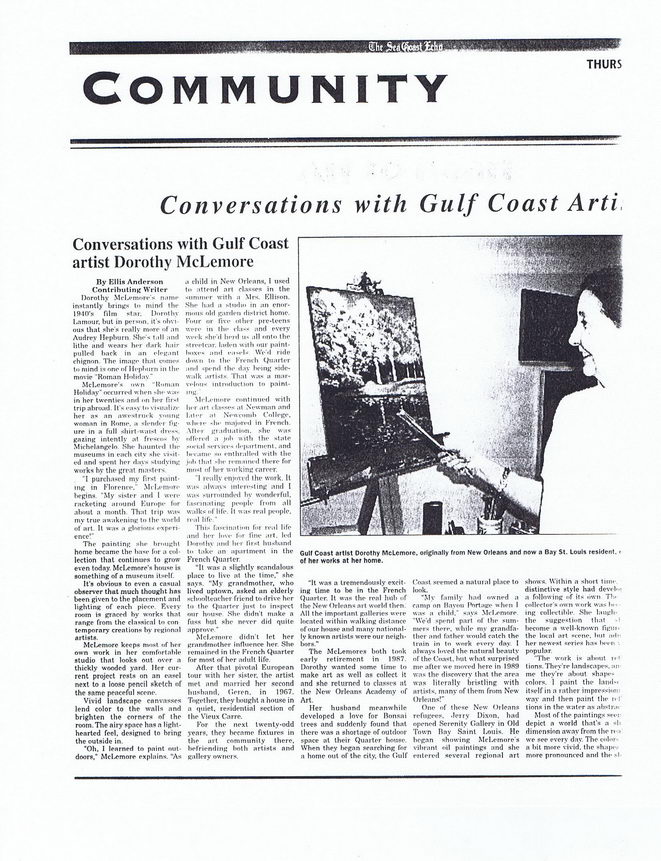This text was obtained via automated optical character recognition.
It has not been edited and may therefore contain several errors.
Community THURS Conversations with Gulf Coast Arti Conversations with Gulf Coast artist Dorothy McLemore By Ellis Anderson Contributing Writer Dorothy McLernore's name instantly limit's to mind the 19-IO?s film star. Dorothy Lamour, but in person, it's obvious that slip's really more of an Audrey Hepburn. She'-; tall and lithe and wears her dark hair pulled back in an elegant chignon. The image that comes to mind is one of I lepburn in the movie "Roman Holiday" McLemore's own "Itnmnn Holiday' occurred when >he was in her twenties and on her first trip abroad. It's easy to visualize her as an awestruck young woman in Home, a slender figure in n full shirt-waist dress, gazing intently at frescos by Michelangelo. She haunted the museums in each city she visit-ed and spent her days studying works bv the great masters. "I purchased my first painting in Florence." McLemore begins. "My sister and I were racketing around Europe for about a month. That trip was my true awakening to the world of art. It was a glorious experience!" The painting she brought home became the base for a collection that continues to grow even today. McI,emnro's house is something of n museum itself. It's obvious to even a casual observer that much thought has been given to the placement and lighting of each piece. Every room is graced by works that range from the classical to con temporary creations by regional artists. McLemore keeps most of her own work in her comfortable studio that looks out over a thickly wooded yard. Her current projcct rests on an easel next to a loose pencil sketch of the same peaceful scone. Vivid landscape canvasses lend color to the walls and brighten the corners of the room. The airy space has a lighthearted feel, designed to bring the outside in. "Oh, I learned to paint outdoors," Mcl-cmore explains. ?As a child in New Orleans, 1 used to attend art classes in the summer with a Mrs. Ellison. She had a studm in an enormous old garden district home. Four or live other pre-teens were in the class and every weel; slic'd herd us all onto the streetcar, laden with our paintboxes and easels We'd ride down to the French Quarter and spend the day being sidewalk artists That was a marvelous introduction to painting. McLemore continued with her art classes at Newman and I.iter al Newcomb College, whi le -he majored in French. Alter graduation, she was offered a job with the state social services department, and became so enthralled with the job I bat she remained there for mosi al her working career. "I really enjoyed the work. It was always interesting and I was surrounded by wonderful, fascinating people from all walks of life. Il was real people, real life." This fascination for real life and her love lor line art. led Dorothy and her first husband to take an apartment in the French Quarter. ?Il was a slightly scandalous place to live at the time," she says. ?My grandmother, who lived uptown, nsked an elderly schoolteacher friend to drive her to the Quarter just to inspect our house. She didn't make a fuss but she never did quite approve." McLemore didn't let her grandmother influence her. She remained in the French Quarter for most of her adult life. After that pivotal European tour with her sister, the artist met and married her second husband, (!eren. in 19f>7. Together, they bought a house in a (juict, residential section of the Vieux Carre. For the next twenty-odd years, they became fixtures in the art community there, befriending both artists and gallery owners. Gulf Coast artist Dorothy McLcmorc, originally from New Orleans and now a Bay St. Louis resident. < of her works at her home. ?It was a tremendously exciting time to be in the French Quarter. II was the real hub of the New Orleans art world then. All the important galleries were located within walking distance of our house and many nationally known artists were our neighbors." The McLemores both took early retirement in 1987. Dorothy wanted some time to make art as well as collect it and she returned to classes at the New Orleans Academy of Art. Her husband meanwhile developed a love for Bonsai trees and suddenly found that there was a shortage of outdoor space al their Quarter house. When they began searching for a home out of the city, the Gulf Coast seemed a natural place to look. ?My family had owned a camp on Bayou I?ortage when I was a child." says Md-emore. "We'd spend part of the summers there, while my grandfather and father would catch the train in to work every day. I always loved the natural beauty of the (.'oast, but what surprised me after we moved here in 19fi9 was the discovery that the area was literally bristling with artists, many of Ihem from New Orleans!" One of these New Orleans refugees. .Jerry Dixon, had opened Serenity Gallery in Old Town Hay Saint Louis. He began showing McLemore's vibrant oil paintings and she entered several regional art shows. Within a short time distinctive style had develm a following of its own Tin collector's own work was bn ing collectible. She laugh-the suggestion that -I become a well-known ligui-the local art scene, but anther newest series has been \ popular. "The work is about ie! lions. They're landscapes, an me they're about shapes colors. 1 paint the land-i itself in a rather impression! way and then paint the ref tions in the water as abstrai Most of the paintings seer depict a world that's a sh dimension away from the re a we see every day. The color-a bit more vivid, the shape.-more pronounced and the si-

McLemore, Dorothy 001